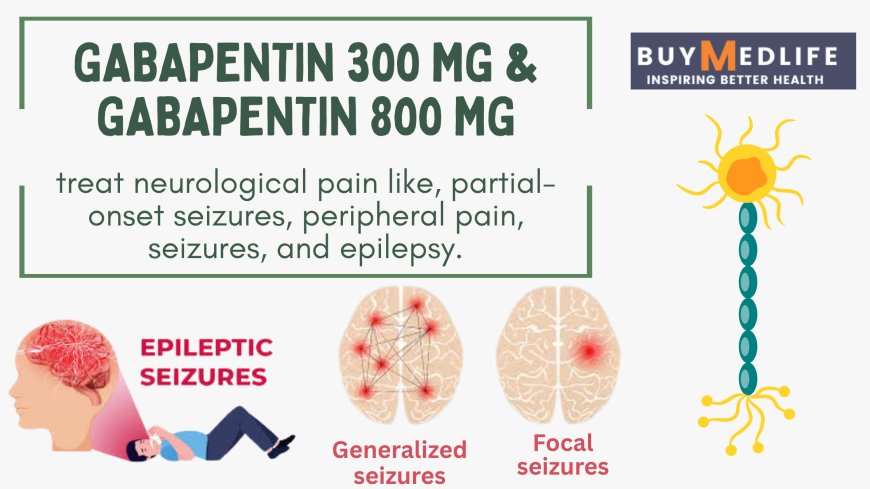Gabapentin 300 mg & 800 mg: Dual Power for Epilepsy & Nerve Pain
Gabapentin 300 mg & 800 mg: Learn how both strengths help manage epilepsy and nerve pain effectively. Find the right dose for your condition.

Gabapentin has become a cornerstone medication for managing both nerve pain and epilepsy, offering flexible treatment in multiple strengths, including 300 mg and 800 mg. While these two dosages may serve different patient needs, both provide effective relief depending on the condition and severity.
This article explores how Gabapentin 300 mg and 800 mg work, how they differ, and how each dose can help those suffering from neuropathic pain and seizure disorders.
What Is Gabapentin?
Gabapentin is an anticonvulsant and nerve pain medication. It works by affecting the way nerves communicate with the brain. Although its exact mechanism isn't fully understood, its believed to calm overactive nerve activity, making it highly effective in treating:
-
Epilepsy (partial seizures)
-
Postherpetic neuralgia (nerve pain after shingles)
-
Peripheral neuropathy
-
Fibromyalgia
-
Restless legs syndrome (off-label)
Gabapentin 300 mg vs. 800 mg: What's the Difference?
Both dosages contain the same active ingredient, but they serve different treatment intensities and patient tolerances.
Gabapentin 300 mg
-
Usually prescribed for mild to moderate nerve pain
-
Common starting dose for new patients
-
Often used to assess tolerance
-
May be taken multiple times a day to maintain consistent relief
Gabapentin 800 mg
-
Prescribed for more severe nerve pain or seizure disorders
-
Suitable for patients who have built up tolerance or need a stronger effect
-
Often used in chronic conditions
-
Typically given after gradually increasing from lower doses
How Gabapentin Helps with Epilepsy
Gabapentin helps control partial seizures by stabilizing electrical activity in the brain. Its typically used as an add-on therapy alongside other antiepileptic drugs. Dosage may vary depending on age, seizure frequency, and other medications.
-
Starting dose: Often 300 mg once daily, then titrated upward
-
Maintenance dose: Can reach 18003600 mg/day, typically split into three doses
-
The 800 mg tablet is useful for convenience and compliance, especially in higher-dose regimens
How Gabapentin Treats Nerve Pain
Gabapentin is FDA-approved for postherpetic neuralgia but is commonly prescribed off-label for various types of neuropathy, including:
-
Diabetic neuropathy
-
Spinal cord injury pain
-
Fibromyalgia-related nerve discomfort
The drug reduces abnormal nerve signals that lead to chronic pain. Many patients start with 300 mg and gradually work up to 600 or 800 mg per dose, depending on symptom severity and side effects.
Common Dosage Schedule
| Condition | Initial Dose | Max Dose |
|---|---|---|
| Epilepsy | 300 mg/day | 3600 mg/day (divided) |
| Nerve Pain | 300 mg/day | 1800 mg/day (divided) |
| Fibromyalgia (off-label) | 300 mg/day | 2400 mg/day (divided) |
Always follow your doctors instructions and never adjust the dosage without medical supervision.
Side Effects to Know
Both 300 mg and 800 mg dosages can cause side effects, particularly when starting or increasing the dose.
Common Side Effects:
-
Drowsiness
-
Dizziness
-
Fatigue
-
Swelling in hands or feet
Less Common:
-
Blurred vision
-
Memory issues
-
Mood changes
If side effects become bothersome, doctors may lower the dose or space out intake.
Choosing the Right Strength
Whether 300 mg or 800 mg is right for you depends on:
-
Your condition (pain vs. seizures)
-
Your response to lower doses
-
Other medications youre taking
-
Age and overall health
Doctors usually begin treatment with Gabapentin 300 mg and gradually increase it to minimize side effects. The 800 mg dose is typically used for maintenance after tolerance and efficacy are established.
Final Thoughts
Gabapentin 300 mg and Gabapentin 800 mg offer flexible, powerful options for managing both nerve pain and epilepsy. Whether you're just beginning treatment or require a higher dose for long-term symptom control, the right dosage can significantly improve your quality of life.
Always consult your healthcare provider before starting, stopping, or adjusting your Gabapentin dose. With the proper dosage and medical guidance, Gabapentin can provide lasting relief and stability.
































